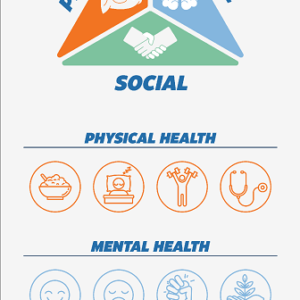Unlock the Holistic Health Perks of holistic health benefits
Holistic health represents a comprehensive approach to well-being, emphasizing the interconnectedness of physical, mental, emotional, social, and spiritual dimensions. This integrative model acknowledges that health is not merely the absence of illness but rather a dynamic state of balance and harmony among these facets. The importance of holistic health lies in its potential to foster a more profound understanding of individual needs and health conditions. For instance, visual tools, such as the wellness diagram illustrated in , effectively convey the various dimensions, promoting awareness of how they influence one another. By adopting a holistic perspective, individuals can engage in a more personalized health journey, making informed decisions that enhance their quality of life. This broader viewpoint not only addresses immediate concerns but also cultivates long-term wellness, ultimately unlocking the myriad benefits that holistic health offers.

II. Physical Benefits of Holistic Health Practices
Holistic health practices encompass a wide array of physical benefits that contribute to overall wellness and vitality. Central to these practices is the integration of physical activity, nutrition, and mindfulness, which fosters not only improved fitness but also enhanced immune response and reduction in chronic diseases. Engaging in practices such as yoga and tai chi, which combine movement with mental focus, has been shown to lower blood pressure and promote flexibility and balance, leading to reduced incidence of falls and injuries, especially among older adults. Additionally, nutrition plays a crucial role, with many holistic approaches emphasizing organic foods that boost nutrient intake, thereby fostering better metabolic health (Admin). The interconnection between physical health and emotional well-being further exemplifies the holistic paradigm, as maintaining physical health positively influences psychological resilience and stress management (Attride-Stirling J et al.). Supporting this multi-dimensional understanding, visually represents the essential components of wellness, elucidating the interconnected nature of physical practices within holistic health.
III. Mental and Emotional Advantages of Holistic Approaches
The mental and emotional advantages of holistic approaches are profound, as they encapsulate a comprehensive perspective on well-being that extends beyond mere symptom management. By integrating physical, emotional, and psychological dimensions, holistic practices cultivate resilience and foster a more harmonious state of mind. This paradigm not only emphasizes the importance of mental health in overall wellness but also advocates for strategies that enhance emotional intelligence, thus significantly improving interpersonal relationships and stress management. Such approaches align with the findings noted in contemporary workplace health studies, which highlight the shifting focus from treatment to preventive measures that promote mental wellness (Karanika-Murray et al.). Furthermore, visuals representing wellness dimensions, such as those presented in , effectively illustrate the variety of holistic health aspects, reinforcing the interconnectedness of these elements. Ultimately, adopting a holistic framework can lead individuals to better self-awareness and a balanced emotional life, echoing published sentiments regarding the therapeutic potential of holistic health interventions (Jackson et al.).
The image presents a circular diagram illustrating the various dimensions of wellness, centered around the term ‘WELLNESS.’ Surrounding this central focus are six visually distinct segments, each represented by icons corresponding to different aspects of wellness: ‘Physical,’ ‘Mental,’ ‘Environmental,’ ‘Social,’ ‘Emotional,’ and ‘Spiritual.’ This diagram emphasizes the interconnected nature of these dimensions, highlighting the holistic approach to wellness that encompasses physical health, mental clarity, emotional well-being, social connections, spiritual fulfillment, and environmental awareness. Such visuals are often used in health education and psychological research to convey the importance of balanced wellness in overall quality of life.
IV. Integrating Holistic Health into Daily Life
Incorporating holistic health practices into daily life necessitates a mindful approach that acknowledges the interconnection between various dimensions of well-being. This integration can manifest through routines that promote physical, emotional, social, and spiritual health, emphasizing the need for balance. For instance, engaging in activities such as yoga or meditation encourages mental clarity and emotional resilience while fostering a sense of spiritual connection. A foundational understanding of wellness can be visually represented through models like the Wellness Wheel, which illustrates the critical balance needed among diverse wellness dimensions, including social and environmental factors . Furthermore, recognizing the impact of nutrition, as highlighted in discussions surrounding holistic approaches, reinforces the importance of healthy eating habits (Admin). Ultimately, integrating these holistic practices into daily routines not only improves individual well-being but also cultivates a supportive environment that aligns with broader health objectives (Asif et al.).
In summary, embracing a holistic approach to health significantly enhances overall well-being, offering a multifaceted perspective that addresses physical, mental, and social dimensions. The integration of various wellness practices—such as those depicted in the Wellness Wheel —illustrates the interconnectedness of different aspects of health, reinforcing the need for a balanced lifestyle. By fostering an awareness of how these segments influence one another, individuals can better navigate their health journeys. Moreover, the emphasis on preventive measures and lifestyle adjustments can empower people to take charge of their well-being while promoting sustainable health practices. Ultimately, the holistic health paradigm encourages a proactive, inclusive view that transcends mere symptom management, thereby unlocking profound benefits that enhance quality of life. The pursuit of holistic health is not merely an option; it is an essential pathway toward achieving optimal wellness and fulfilling ones potential.
The image depicts a ‘Wellness Wheel,’ which visually represents the various dimensions of wellness in a circular format. The wheel is divided into eight segments labeled ‘Social,’ ‘Spiritual,’ ‘Emotional,’ ‘Occupational,’ ‘Intellectual,’ ‘Physical,’ ‘Environmental,’ and ‘Financial.’ Each section includes a simple icon that symbolizes the respective aspect of wellness, providing a clear and concise overview of the holistic concept of well-being. The central text labels the wheel itself, emphasizing its focus on overall wellness, which is relevant for discussions in health, psychology, and well-being studies.
References:
Admin. “Tips for Cultivating Well Health the Organic Way”. Well Health Organically, 2025, https://wellhealthorganically.in/category/general-wellness/





